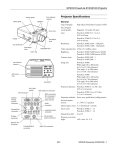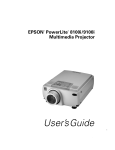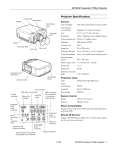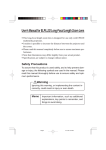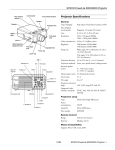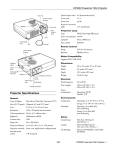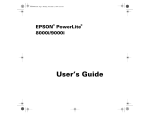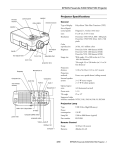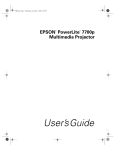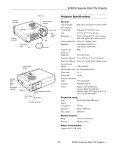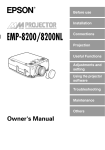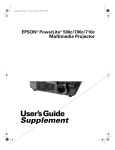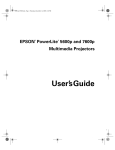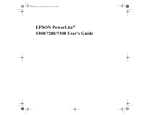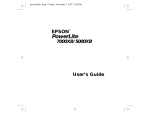Download Epson PowerLite 8150i Specifications
Transcript
EPSON PowerLite 8150i Projector Projector Specifications front remote control sensor control panel speaker status lights General zoom ring projection lens handle Poly-silicon Thin Film Transistor (TFT) Size of liquid crystal panels Diagonal: 1.3 inches (33.6 mm) Lens F=1.7 to 2.3, f=49 to 63 mm Resolution 1024 × 768 pixels Color reproduction 24 bit, 16.7 million colors foot adjust lever lens shift knob foot adjust lever Type of display Brightness 3200 lumens (ANSI) Image size Wide angle: 28 to 300 inches (at 3.3 to 37.3 feet distance) adjustable feet Tele angle: 21 to 300 inches (at 3.1 to 48.1 feet distance) focus ring Projection distance 3.1 to 48.1 feet (.9 to 14.6 meters) RJ45 (Ethernet 10/100) connector memory card slot Projection methods Front, rear, upside-down (ceiling mount) USB ports Internal speaker system Optical aspect ratio 4:3 (horizontal:vertical) rear remote control sensor 1:1.3 Tilt angle 0 to 15° Lens shift DVI / VGA switch VGA (video in) connector DVI connector optional remote receiver connector BNC connectors (for Computer 2 or component video source) Computer 1 G/Y B/Cb/Pb H/C Sync V Sync Audio Remote Mouse/Com S-Video S-Audio/Audio2 Monitor Out Video Stack Out Type UHE (Ultra High Efficiency) Power consumption 230 W Lamp life About 2000 hours Part number ELPLP11 Remote Control Computer 2 /Component Video R/Cr/Pr 0 to 10° Projection Lamp see below S-video connector Zoom ratio Keystone correction angle ±30° (ratio: 10.0 to 5.5) A/C power inlet Mouse/Com connector 3-watt, 8-Ω stereo speakers Audio 1 connector Range 32.8 feet (10 meters) Batteries Alkaline AA (2) composite video connector Mouse Compatibility Supports PS/2, USB, serial, ADB L-Audio-R left and right audio connectors Remote IR Receiver Supports EPSON Remote IR Receiver, 10-foot cable (typically used for rear screen projection) Monitor Out connector S-Audio/Audio 2 connector Stack Out connector 5/01 EPSON PowerLite 8150i Projector - 3 EPSON PowerLite 8150i Projector Dimensions Mode Resolution Frequency H(KHz)/V(Hz) Dot (MHz) 17.6 inches (448 mm) VGACGA VGAEGA 640 x 400 640 x 350 31.46 / 70 31.46 / 70 25.175 25.175 20 lb (9.1 kg) NEC400 640 x 400 24.83 / 56.65 21.053 Rated frequency 50 to 60 Hz Power supply 100 to 120 VAC, 4.0 A 200 to 240 VAC, 2.0 A VGA60 VGA72 VGA75 VGA85 VGA100 VGA120 640 x 480 640 x 480 640 x 480 640 x 480 640 x 480 640 x 480 31.469 / 59.94 37.861 / 72.809 37.5 / 75 48.269 / 85.008 51 / 100 61 / 120 25.175 31.5 31.5 36 42.5 50.8 SVGA56 SVGA60 SVGA72 SVGA75 SVGA85 SVGA100 SVGA120 800 x 600 800 x 600 800 x 600 800 x 600 800 x 600 800 x 600 800 x 600 35.156 / 56.25 37.879 / 60.317 48.077 / 72.188 46.875 / 75 53.674 / 85.061 63 / 100 76 / 120 36 40 50 49.5 56.25 67 80 XGA43i XGA60 XGA70 XGA75 XGA85 XGA100 XGA120 1024 x 768 1024 x 768 1024 x 768 1024 x 768 1024 x 768 1024 x 768 1024 x 768 35.522 / 86.958 48.363 / 60.004 56.476 / 70.069 60.023 / 75.029 68.677 / 84.997 81 / 100 97 / 120 44.9 65 75 78.75 94.5 111 133 SXGA1_70 SXGA1_75 SXGA1_85 SXGA1_100 1152 x 864 1152 x 864 1152 x 864 1152 x 864 63.851 / 70.012 67.5 / 75 77.094 / 84.999 90 / 100 94.5 108 121.5 144 SXGA2_60 SXGA2_75 SXGA2_85 1280 x 960 1280 x 960 1280 x 960 60 / 60 75 / 75 85.938 / 85.002 108 126 148.5 SXGA3_43i SXGA3_60 SXGA3_75 SXGA3_85 1280 x 1024 1280 x 1024 1280 x 1024 1280 x 1024 46.433 / 86.871 63.981 / 60.02 79.976 / 75.025 91.146 / 85.024 78.75 108 135 157.5 UXGA48i UXGA60 UXGA65 UXGA70 UXGA75 UXGA80 UXGA85 1600 x 1200 1600 x 1200 1600 x 1200 1600 x 1200 1600 x 1200 1600 x 1200 1600 x 1200 62.5 / 96.080 75 / 60 81.25 / 65 87.5 / 70 93.75 / 75 100 / 80 106.25 / 85 135 162 175.5 189 202.5 202.5 202.5 MACLC13 MACII13 MAC16 MAC19-60 MAC19 MAC21 iMac VGA iMac SVGA iMac XGA 640 x 480 640 x 480 832 x 624 1024 x 768 1024 x 768 1152 x 870 640 x 480 800 x 600 1024 x 768 34.975 / 66.62 35 / 66.67 49.725 / 74.55 48.193 / 59.28 60.241 / 74.93 68.682 / 75.062 60.49 / 117 60.33 / 95 60 / 75 31.33 30.24 57.28 64 80 100 50.39 62.62 78.7 HDTV480P (ANSI/SMPTE) 720 x 483 31.469 / 59.940 27 HDTV480P (ATSC) 704 x 480 31.469 / 59.940 27 HDTV480I (ANSI/SMPTE) 720 x 487 15.734 / 59.940 13.5 Height 7.4 inches (188 mm) Width 12.0 inches (305 mm) Depth Weight Electrical Power consumption Operating: 370 W Standby: 40 W Environmental Temperature Operating: 41 to 104° F (5 to 40° C), non-condensing Storage: 14 to 140° F (–10 to 60° C), non-condensing Humidity Operating: 20 to 80% RH, non-condensing Storage: 10 to 90% RH, non-condensing Safety United States FCC Part 15J Class B UL1950 Rev. 3 Canada DOC SOR/88-475 CSA C22.2 No. 950 Rev. 3 CE Marking Directive 89/336/EEC EN 55022 Class B EN 50082-1 Directive 73/23/EEC EN 60950 Compatible Video Formats The projector supports computer displays ranging from VGA through UXGA. EPSON’s patented SizeWise™ chip automatically resizes images as needed to display in the projector’s native format. The projector also supports the new Digital Visual Interface (DVI) format, as well as NTSC, PAL, SECAM, and HDTV international video standards. To project images output from a computer, the computer’s video card must be set at a refresh rate (vertical frequency) that’s compatible with the projector; see the following table for compatible formats. Note that the frequencies of some computers may not allow images to be displayed correctly; see your computer’s documentation for details. 4 - EPSON PowerLite 8150i Projector 5/01 EPSON PowerLite 8150i Projector Lenses, Image Size, and Projection Distance Mode Resolution Frequency H(KHz)/V(Hz) Dot (MHz) HDTV480I (ATSC) 704 x 480 15.734 / 59.940 13.5 HDTV720P (SMPTE) 1280 x 720 44.955 / 59.940 74.176 HDTV1080P (ANSI/SMPTE) 1920 x 1080 67.433/ 59.940 148.352 HDTV1080I (ANSI/SMPTE) 1920 x 1080 33.716 / 59.940 74.176 NTSC (XGA) 1024 x 438 15.734 / 60 20.89 PAL (XGA) 1024 x 512 15.625 / 50 21.154 Note: The screen size may vary if you tilt the projector up by extending the feet or use electronic keystone correction. SECAM (XGA) 1024 x 512 15.625 / 50 21.154 Standard Lens Follow the guidelines below when selecting a lens and positioning the projector. Minimum and maximum screen sizes are given for each lens type, along with the corresponding projection distance (usually given as a range, since the zoom ring can be used to change the image size). For other screen sizes, use the EPSON Projection Distance Calculator, available by download at http://support.epson.com. Minimum screen size: 21 inches (53 cm) at a distance of 37.8 inches (90 cm), using the full-tele setting Computer Video Port Pin Assignments Maximum screen size: 300 inches (762 cm) at a distance of 38 to 48 feet (11.4 to 14.6 m) The Computer 1 analog port and the Monitor Out port are female video RGB, 15-pin micro-D-style connectors. Here are their pin assignments: Long Throw Zoom Lens (ELPLL02) Minimum screen size: 60 inches (153 cm) at a distance of 10 to 17 feet (300 to 510 cm) Pin # Computer 1 port Monitor Out port 1 Red video Red out / red video 2 Green video Green out / green video Extra Long Throw Zoom Lens (ELPLL03) 3 Blue video Blue out / blue video 4 Monitor (ID bit 2) Reserved Minimum screen size: 60 inches (153 cm) at a distance of 28.2 feet (8.6 m), using the full-tele setting 5 GND GND 6 Red video GND GND 7 Green video GND GND 8 Blue video GND GND 9 NC Reserved 10 Synchronous GND GND 11 Monitor (ID bit 0) Reserved 12 SDA Reserved 13 Horizontal sync Horizontal sync 14 Vertical sync Vertical sync 15 SLC Vertical sync Maximum screen size: 300 inches (762 cm) at a distance of 51 to 86 feet (15.6 to 26.4 m) Maximum screen size: 300 inches (762 cm) at a distance of 108 to 145 feet (32.8 to 44.3 m) Short Throw Zoom Lens (ELPLW01) Minimum screen size: 60 inches (152 cm) at a distance of 65 to 77 inches (170 to 190 cm) Maximum screen size: 200 inches (508 cm) at a distance of 19 to 22 feet (5.7 to 6.8 m) Fixed Short Throw Lens (ELPLR01) Minimum screen size: 60 inches (153 cm) at a distance of 46 inches (120 cm) Maximum screen size: 100 inches (254 cm) at a distance of 78 inches (200 cm) 5/01 EPSON PowerLite 8150i Projector - 5 EPSON PowerLite 8150i Projector Adjust the height of the image using the lens shift knob, as shown below. If the knob is recessed, press and release it so that it extends; then turn it clockwise or counterclockwise to move the image up or down. When you’re finished, press the knob back in. Positioning the Projector The projector can be installed in three ways: ❏ front projection Place the projector on a sturdy, level surface, making sure there is plenty of space for ventilation around and under the projector. ❏ overhead projection To project from overhead, select Ceiling in the projector’s Advanced menu. To mount the projector, use the special attachments and adapters listed in “Optional Accessories” on page 14. ❏ rear-screen projection To project from behind a semi-transparent screen, select Rear Proj. in the projector’s Advanced menu. lens shift knob When equipped with the standard lens, you can place the projector anywhere from 21 inches to 48 feet from the screen. Image size varies with projection distance, as shown below; for more information, see page 5. 43 ft 8 ft 4 ft If the image still isn’t high enough, you can raise it further using the projector’s feet. Pull up on the blue foot release levers to release the feet. distance from screen Be sure to center the projector in front of the screen (not off to one side at an angle), or your image won’t be square. Adjusting the Height of the Image You won’t need to tilt the projector upward as long as you position it so that its lens is at least as high as the bottom of the screen, but no higher than the middle of the screen, as shown. This delivers the best-looking picture. Once the image is positioned where you want it, release the levers to lock the feet in position. You can fine-tune the height of the projector by turning the feet. If the image is no longer square after raising it, see the following section. no higher than middle of screen Correcting Keystone Distortion If the projected image isn’t square or has “keystone” shape, press the Keystone button on top of the projector to correct it. Press on the right + or left – side of the Keystone button until the image looks correct. ideal range no lower than bottom of screen S y n c. Keystone Volume After correction, your image will be slightly smaller. Note: You can also correct the keystone shape using the projector’s Setting menu. 6 - EPSON PowerLite 8150i Projector 5/01 EPSON PowerLite 8150i Projector Insert the card into the PCMCIA slot on the projector: Presenting Without a Computer The projector’s EasyMP.net features let you transfer computer presentations directly to the projector (over a network) and then deliver them without having to connect a PC or laptop. EasyMP.net supports the following applications and image formats: ❏ PowerPoint 97 and 2000 ❏ Word 97, 98, and 2000 (including multi-page files) Configuring the Projector to the Network ❏ Excel 97 and 2000 (including multi-sheet files) You can follow the steps below to set up the projector if all systems that need to access it are on the same subnet. For other network configurations, or to give the projector access to shared drives on remote PCs, see the Administrator’s Manual. ❏ text (including unicode) and rich text format (RTF) ❏ jpeg (JPG), bitmap (BMP and DIB), and portable network graphics (PNG) 1. Connect a USB mouse and USB keyboard to the projector’s USB ports, as shown below. Note: Certain applications may not look or work exactly the same as on your computer. See the Notices section in the Administrator’s Manual for details. USB ports Connecting to Your Network To use your projector’s network features, you need to have a Microsoft network running TCP/IP. Connect the projector to your network and insert its memory card, as described below. 1. Connect the projector using a standard (Category 5 UTP) network cable. Plug it into the RJ45 connector on the back of the projector as shown: If you don’t have a USB mouse, you can use the projector’s remote control to point and click. (Make sure the remote control is turned on, using the switch on its side.) If you don’t have a USB keyboard, you can use the projector’s software keyboard; see the Administrator’s Manual for details. 2. Press the Power button to turn on the projector (see “Using the Control Panel” on page 12). Wait until you see the EasyMP.net screen: click here 2. Make sure the projector’s memory card is installed. (The projector comes with a 16-megabyte CompactFlash card, but you can purchase larger-size cards. The projector also supports ATA flash cards and ATA HDD cards.) If necessary, place the memory card in the card adapter: If you don’t see this screen, press the Comp/Easy-MP button on the control panel. (You may need to press it more than once.) 3. Click the Easy Configuration icon, as shown above. 5/01 EPSON PowerLite 8150i Projector - 7 EPSON PowerLite 8150i Projector 4. On the next screen, click the Network icon. You see this screen: Follow these steps to send your presentation from your office PC to the projector: 1. Click Start, Programs, EasyMP, then select EMP File Utility. You see this screen, with the files on your PC listed on the left: PC files click here 5. Enter the necessary parameters (IP address, subnet mask, or others as needed) to give the projector a unique address on your network, then click Set. For details, see the Administrator’s Manual. 2. Click the Connect icon, as shown above. You see this screen: 6. Enter a name for the projector so that users can easily identify it, then click Set. select projector name and click OK 7. Turn off the projector and restart it so the settings can take effect. Transferring Your Presentation to the Projector After installing the EasyMP.net software, as described in the Administrator’s Manual, you can use it to send presentations from your office PC to the projector. You can also get your presentation to the projector in one of these ways: 3. Select the name of your projector, then click OK. (If you have more than one projector, you may need to click the drop-down arrow and select the correct projector from the list. If it isn’t listed, click the Search button; see the Administrator’s Manual for details.) ❏ If your computer has a PCMCIA slot, you can copy your presentation directly onto a memory card, then insert the card in the projector. All files currently stored on the projector appear on the right, as shown: ❏ If the projector and your PC are properly set up, you can use the projector to download your presentation while you’re in the meeting room. ❏ If you have a networked laptop in the meeting room, you can drag your presentation onto the EMP Tablet software icon on your desktop to start and run your presentation; you don’t have to copy it to the projector beforehand. projector files Note: If your laptop is equipped with a wireless Ethernet card, you won’t have to worry about connecting any cables before starting your presentation. 4. To copy your presentation to the projector, highlight its name on the left side of the screen, then highlight the folder’s name where you want to copy it on the right side of the screen. Then click the copy icon. 8 - EPSON PowerLite 8150i Projector 5/01 EPSON PowerLite 8150i Projector Viewing Your Presentation Projector Status Lights Once you’ve copied your presentation to the projector’s memory card, follow these steps to get it running: The lights on top of the projector indicate the projector’s operating status. 1. If necessary, press the Comp/Easy-MP button to switch to EasyMP.net: power light click here lamp light temperature light Light 2. Click the Easy View icon, shown above. You see this screen: Status Description and action off Make sure the power cord is connected. If you’ve just replaced the lamp, make sure its cover is fastened securely. green The projector is operating normally. flashing green The projector is warming up. Wait for the image to appear. orange The projector is in sleep mode and can receive data over the network. Unplug the projector to turn it off, or press the Power button to turn it on. flashing orange The projector is cooling down. Don’t unplug the projector until the light stops flashing. If you want to turn the projector back on, wait until the light stops flashing and press the Power button. red Power is cut off because of an internal problem. Contact EPSON for help. flashing orange The lamp is almost burned out. This is a good time to replace it. flashing red The lamp is burned out or there is a problem with the lamp’s ballast. flashing orange The projector is getting too hot. Turn it off and let it cool before using it. red The projector has overheated and turned off automatically. Let it cool for a few minutes, then turn it back on. Make sure there is plenty of space around and under the projector for ventilation. If it continues to overheat, you may need to change the air filter. flashing red There is a problem with the cooling fan or temperature sensor. Turn off the projector and unplug it. Contact EPSON for help. click here make sure this box is checked 3. Click Viewer. Locate your presentation’s file name in the file window. 4. To start your presentation, double-click its file name, or highlight it and click the Play icon. For more information, see the User’s Guide to learn about: ❏ controlling your presentation ❏ using the EMP Tablet software to draw on the screen ❏ connecting a drawing tablet to the projector or your laptop ❏ saving your on-screen drawings and notes as “meeting minutes” (an HTML file you can share on the network) 5/01 EPSON PowerLite 8150i Projector - 9 EPSON PowerLite 8150i Projector See the next page for information on using the remote control buttons, shown below: Using the Remote Control The remote control uses a line-of-sight infrared signal. It lets you access the projector’s features from anywhere in the room—up to 32 feet away. You can point the remote either at the front or back of the projector or at the screen. Freeze A/V mute Power Freeze Power A/V Mute E-Zoom E-Zoom 2 ❏ when using EasyMP.net light button The remote control lets you select the image you want to view, click through your PowerPoint slides, and draw on the screen to highlight your presentation. 1 5 Special effects buttons (1-5) on/off switch 3 4 In addition to the functions described on the next page, you can also use the remote control as a wireless mouse in the following situations: R/C ON OFF Enter Enter (pointer) button Esc button Esc ❏ when presenting from a computer cover If you’re presenting from a laptop instead of using EasyMP.net, you can use the remote control’s built-in pointer and highlighting features. These let you annotate your presentation on-screen. You can also use the remote control in place of your computer’s mouse. This gives you more flexibility when delivering PowerPoint and other slideshow-style presentations, since you won’t need to stand next to your computer to change slides. To use the remote control in this way, you have to connect the projector’s mouse cable between your computer and the projector. Open the cover just below the Esc button to access these remote control buttons: Esc Menu ❏ when accessing the projector’s help and menu functions Help Comp1 The remote control lets you access and use the projector’s help system. It also lets you navigate the menu system to fine-tune various projector features. Comp2/YCbCr Comp1 Comp2/ YCbCr Video Video EasyMP.net Capture/ Auto Note: If the remote control isn’t working, make sure the on/off switch on its side is turned on and fresh batteries are installed. The remote control also may not work properly if a strong light source or radiant heater is present. 10 - EPSON PowerLite 8150i Projector Help Menu picture-inpicture Capture Auto APPs Resize P in P Preset APPs/ Resize Preset - Volume + Volume 5/01 EPSON PowerLite 8150i Projector This table summarizes the functions on the remote control. Button Function Power Starts or stops projection. on/off switch Turns the remote control on or off. Prevents the batteries from discharging if something presses against one of the buttons in the carrying case. Freeze Keeps the current computer or video image on the screen. A/V mute Turns off the audio and video, displaying either a blank screen or the user’s logo. E-Zoom Enlarges the image up to four times (in 32 steps). Pressing the right side of the button enlarges the image, pressing the left side of the button reduces the image. To display a portion of an enlarged image that is outside the display area, press the Enter button and scroll the image to the desired location. Effects buttons Enter (pointer button) Display preprogrammed special effects on the screen (see table at right). Additional effects can be selected through the Effect menu or by using the EMP Link V software. Button Function P in P Displays a composite video or S-video image in a subscreen on the main display. Use the Enter button to reposition the Picture in Picture (P in P) screen, or the E-Zoom button to enlarge or reduce the image. Changes made to the P in P screen location and size are automatically carried over to the next P in P session. Preset Saves and recalls up to five different session settings (resolution, tracking, sync signal, and position). To save the current session settings, press the Preset button to assign it to the next available number, 1 through 5. To recall a setting, press the Preset button a second time and move to the desired session number. To overwrite a saved setting, move to the setting you want to replace and press Enter. When the confirmation message displays, choose Yes and press Enter. – Volume + Adjusts the volume. The five special effects buttons are preprogrammed with the following functions: Use the Enter button like a mouse to navigate through EasyMP.net, or to make selections in the projector’s help and menu systems. Also lets you position special effects on the screen and can be used in place of your computer’s mouse when the computer is connected with the projector’s mouse cable. Pressing the Enter button acts as a left mouse click. Button Function 1 Changes the mouse cursor to an arrow or stamp 2 Lets you draw one or more boxes on the screen 3 Spotlights a section of the screen Light Illuminates all buttons on the remote control temporarily. 4 Lets you place a vertical or horizontal bar on the screen to highlight a part of your image Esc Stops the current function. Pressing Esc while viewing a menu or the online help displays the previous screen or menu. Also functions as a right mouse click. 5 Erases the drawing effects on the screen Menu Displays or hides the menu. Help Displays the online help menu. Comp1 Switches to the Computer 1 image. Comp2/YCbCr Switches to the Computer 2 or component video source. EasyMP.net Switches the source to the EasyMP.net screen. Video Switches to the composite video or S-video source. Capture/Auto When EasyMP is running, can be used to capture an image. Otherwise, optimizes the image from a connected computer. APPs/Resize When EasyMP is running, calls up a menu of applications. Otherwise, can be used to manually resize the computer image. Note: You can use the projector’s Effect menu to select different options for each of the drawing tools. 5/01 EPSON PowerLite 8150i Projector - 11 EPSON PowerLite 8150i Projector Using the Control Panel Power Help Menu Cleaning the Lens Warning: Before you clean any part of the projector, turn off the projector and unplug the power cord. Never open any cover on the projector, except the lamp and filter covers. Dangerous electrical voltages in the projector can injure you severely. Do not try to service this product yourself, except as specifically explained below. Refer all other servicing to qualified service personnel. Esc Sync. king Trac Tracking Video Comp/ A/V mute S y n c. Keystone Resize Clean the lens whenever you notice dirt or dust on the surface. Shift Volume ❏ Lightly wipe the lens surface with a soft, dry, lint-free cloth. ❏ To remove dirt or smears on the lens, moisten a soft cloth with an alcohol-based cleaner and gently wipe the lens surface. The following table summarizes the functions on the control panel: Button Function Power Starts or stops projection. Help Displays the online help menu. Comp/ EasyMP.net Switches between Computer 1, Computer 2, and EasyMP.net. Before you clean the projector case, turn off the projector and unplug the power cord. A/V mute Turns off the audio and video, displaying the black, blue, or user logo background. ❏ To remove dirt or dust, wipe the case with a soft, dry, lintfree cloth. Resize Switches the display dot mode and resize mode for VGA, SVGA, SXGA, and UXGA input. ❏ To remove stubborn dirt or stains, moisten a soft cloth with water and a neutral detergent. Then wipe the case. Video Switches between composite video, S-video, and component video (BNC). ❏ Do not use alcohol, benzene, thinner, or other chemical detergents. These can cause the case to warp. Menu Displays or hides the menu. Esc Stops the current function. Pressing Esc while viewing a menu or the online help displays the previous screen or menu. When the image source is Computer, the Esc button acts as a mouse right-click. Up, down arrows (Sync+/Sync-) Synchronizes the computer’s graphic signal. Use these buttons to adjust an image that is fuzzy or streaked, or to select menu items. Allows movement or selection of a menu, if a menu is displayed. Left, right arrows (tracking-/ tracking+) Matches the projector’s internal clock to computer graphic signals (tracking adjustment). Use these buttons to adjust an image with vertical fuzzy lines, or to change numeric settings during menu operations. Allows movement of a menu, if a menu is displayed. Enter Selects a menu option or the next menu/help screen. Pressing Enter when no menu or help screen is displayed optimizes the computer image. Shift Pressing the shift and Keystone buttons at the same time increases or decreases the volume. – Keystone + Squares up the screen, correcting up to a ±30° tilt. – Volume + Adjusts the volume when used in conjunction with the Shift button. 12 - EPSON PowerLite 8150i Projector Cleaning the Projector Case Cleaning the Air Filter Clean the air filter at the bottom of the projector after every 100 hours of use. If it is not cleaned periodically, it can become clogged with dust, preventing proper ventilation. This can cause overheating and damage the projector. Follow these steps: 1. Turn off the projector and unplug the power cable. 2. Turn the projector on its side so that the handle is on top and you can access the filter easily. Note: Standing the projector with the handle at the top keeps dust from getting inside the projector housing. 5/01 EPSON PowerLite 8150i Projector 4. Use a screwdriver to loosen the two retaining screws on the lamp cover. When the screws are loose, lift off the lamp cover. (You cannot remove these screws from the cover.) 3. Pull the filter cover up and remove it. 4. The filter is attached to the inside of the filter cover. It is recommended that you use a small vacuum cleaner designed for computers and other office equipment to clean the filter. If you don’t have one, use a dry, lint-free cloth. 5. Use a screwdriver to loosen the three screws holding the lamp unit in place. (You cannot remove these screws completely.) Then lift up the handle and pull out the lamp unit. If the dirt is difficult to remove or the filter is torn, replace it. 5. Replace the filter cover when you’re done. Replacing the Lamp The projection lamp typically lasts for about 2000 hours of use. It is time to replace the lamp when: handle ❏ The projected image gets darker or starts to deteriorate. ❏ The lamp light is flashing red or orange. ❏ The message LAMP REPLACE appears on the screen when the projection lamp comes on (after about 1900 hours). To maintain the projector brightness and image quality, replace the lamp as soon as possible. 6. Gently insert the new lamp unit by lowering it into position. Make sure it’s inserted securely. Tighten the screws on the new lamp unit. Warning: Let the lamp cool before replacing it. Also, do not touch the glass portion of the lamp assembly. Touching the glass portion of the lamp can result in premature lamp failure. 1. Turn off the projector and unplug the power cable. 2. Allow the projector to cool down for at least an hour (if it has been on). 3. Turn the projector so you can see the lamp cover. 5/01 EPSON PowerLite 8150i Projector - 13 EPSON PowerLite 8150i Projector 7. Replace the lamp cover and tighten the screws. (Make sure the lamp cover is securely fastened. The projector turns itself off if the lamp cover is open.) Product number Product 8. Reset the lamp timer as described below. VGA to 13W3 video cable (for connecting to certain high-end workstations) Resetting the Lamp Timer VGA computer cables: HD15/HD15 (1.8 meters) HD15/HD15 (3.0 meters) After you install a new lamp, you need to reset the timer so the projector can keep track of how many hours it has been used. Follow these steps: 1. Press the Help button and hold it down for at least 5 seconds. The Help menu will be displayed and then you will see a menu asking if you want to reset the lamp ON time. 2. Use the left arrow button (control panel) or press left on the Enter button (remote control) to select Yes. ELPKC06 ELPKC02 ELPKC09 Macintosh adapter set (includes monitor adapter and desktop adapter) ELPAP01 Communication cable set (for connecting a second computer; includes a Mac adapter set so you can connect a second Macintosh) ELPKC04 You can purchase these accessories from your dealer or by calling EPSON at (800) 873-7766; or visit the EPSON StoreSM at www.epsonstore.com (U.S. sales only). In Canada, please call (800) 873-7766 for dealer referral. 3. Press Enter to reset the timer. Optional Accessories To see our full line of multimedia projectors, please visit www.epson.com/mul_proj. EPSON provides the following optional accessories for the PowerLite 8150i: Product Product number Replacement lamp and air filter ELPLP11 Short throw zoom lens Related Documentation CPD-11970 EPSON PowerLite 8150i Administrator’s Manual ELPLW01 CPD-11971 EPSON PowerLite 8150i User’s Guide Long throw zoom lens ELPLL02 Service Manual TBD Extra long throw zoom lens ELPLL03 Parts Price Lists PL-EMP8150 Fixed short throw lens ELPLR01 Ceiling mount ELPMB31 Suspension adapter for ceiling mount ELPMBAST Kensington security lock ELPSL01 Insta Theatre portable projection screens: 50-inch 60-inch 80-inch ELPSC06 ELPSC07 ELPSC08 Wireless microphone and two satellite speakers ELPCVS1 Auxiliary audio system ELPPAS1 Remote control receiver (plugs into projector to extend range of remote control) ELPST02 Remote control receiver kit (includes standard receiver and clip-on attachment for connecting directly to remote control) ELPST04 Digital video cables: DVI to DVI, 10 feet (3 meters) DVI to DFP, 10 feet (3 meters) 14 - EPSON PowerLite 8150i Projector ELPKC20 ELPKC21 5/01












